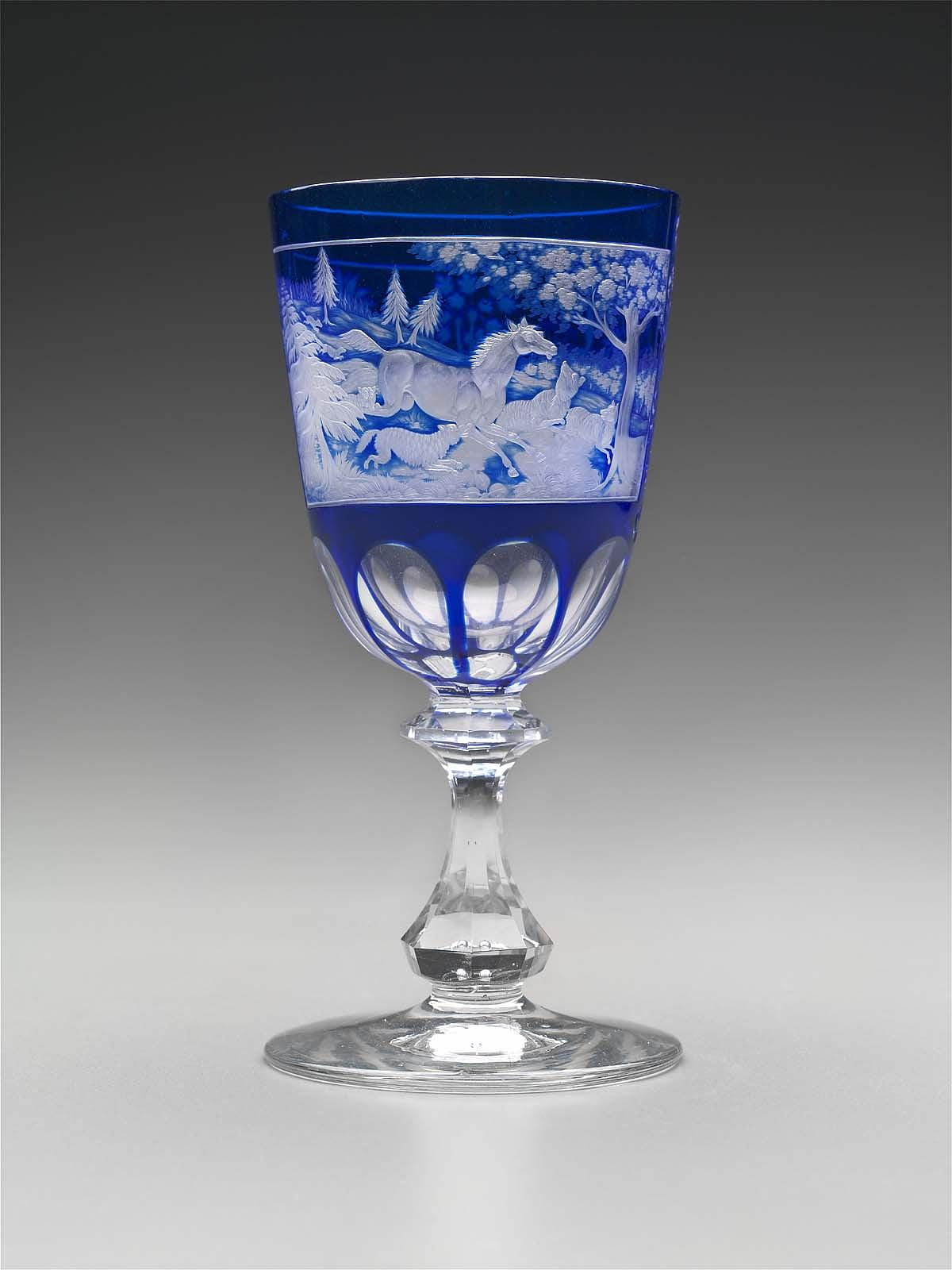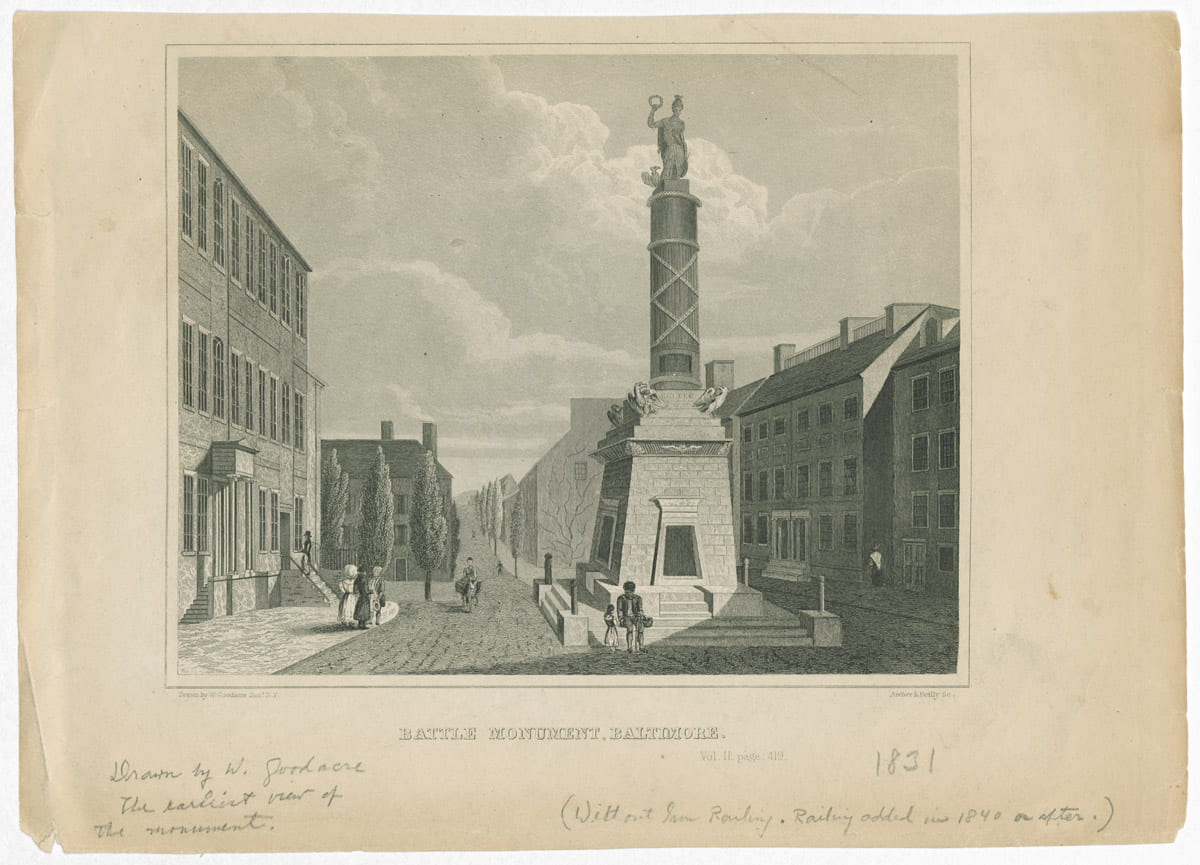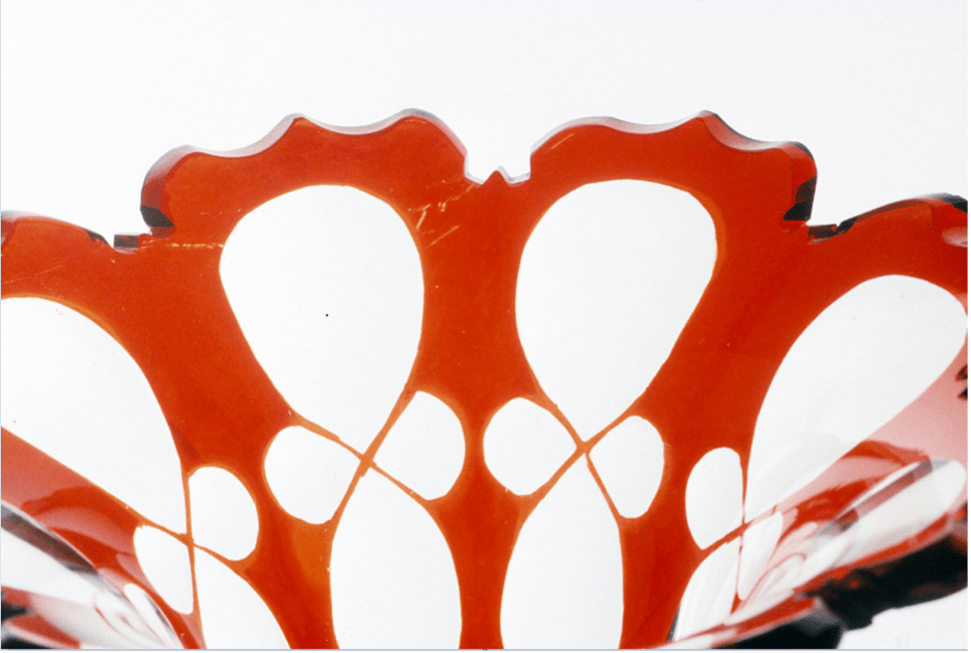The Scenic Route: Winterthur’s Americo-Bohemian Vases
By Rachael Kane, ’22
As a child, I loved kaleidoscopes, with their visions of twisting, shifting colors as small glass pebbles knit and unknit themselves in fantastical patterns. I had a similar reaction to a pair of highly decorated glass vases at the Winterthur Museum. Dated between 1840 and 1860, these vases feature the distinctive patterning of the Bohemian glass tradition. However, upon closer inspection, I noticed that these vases are engraved with two American scenes: The Battle Monument of Baltimore and the President’s House. These engravings mark these vases as an example of scenic glass; a term that I will use to refer to glass objects depicting identifiable landmarks, rather than more general landscape images. While looking at the vases, I felt there to be a visual dissonance between the heavily European inspired aesthetics and the distinctly American engraved scenes. In researching this phenomenon, it became apparent that these vases are part of a larger movement referred to as Americo-Bohemian glass. Scholars like Jane Shadel Spillman still wrestle with this dual identity, and debates continue about whether the makers of these objects were European or American. An examination of these vases reveals their unique transnational history, shedding light on an elusive material category and illuminating their place at the intersection of global material histories, design imitation, and the development of American national identity.

Two Americo-Bohemian glass vases in Winterthur’s collection. Left, 1992.10119.002; Right, 1992.0119.001.
Both vases are made from glass blown into a tall baluster form, with an additional glob of glass added to create the base. These vases are made from non-lead glass, providing the first clue about their makership: during the nineteenth century, American craftspeople were producing only lead glass, while Bohemia was famous for its non-lead glass, suggesting a European origin for these vases. Such an identification is consistent with the cut patterns on the vases, such as the Vandyke edge at the top, a reference to the fanciful lace ruffs of Anthony Van Dyck’s seventeenth-century portraits. Bohemian glass was first produced in the thirteenth century, and soon emerged as a popular alternative to Venetian glass. Bohemian glass objects were frequently decorated with brightly colored stains, heavily cut surfaces and extensive engravings, and were immensely popular between the sixteenth and eighteenth centuries.

A portrait by Van Dyck depicting the nominal lace collars. Charles I (1600-1649), Anthony Van Dyck (1599-1641), c.1635, Oil on canvas, RCIN 404420, Royal Collection Trust. https://www.rct.uk/collection/search#/3/collection/404420/charles-i-1600-1649.
Bohemian glass was often “flashed,” or tinted, with brightly colored exterior layers. The red we see on these vases was a common choice. Made from a copper sulfate substrate, this brilliant ruby tone is the result of a thin, transparent coating over the blown form. However, upon closer inspection, the tint looks awkwardly applied. Typically, glass would be flashed and then cut, creating clean, perfectly matched edges on the incised decorations. These vases were cut first and then flashed, leaving uneven edges and mismatched decorative elements. This unexpected procedure suggests that these vases may have been produced as blanks, or unfinished bodies exported to a different studio for finishing. Despite a waning interest in the art form, during the early nineteenth century many Bohemian companies began exporting blanks abroad, allowing for individual makers to tailor a base object to local tastes. These vases may have been exported as blanks to the United States, where they would have been flashed and engraved for the American market. Material evidence suggests that the engraving was the final element completed. After the red tint was applied, the engraving was cut into the oval reserve on the front of the object, decorated with strawberry diamond patterns and rococo foliate scrolls. The engraving itself suggests a high level of skill: the windows have even been re-polished after the engraving was finished to mimic the effect of clear panes.
Europe also began to export talent. German and Czech glass artisans moved abroad, bringing their training to other regions. Archival evidence establishes Bohemian trained glass artisans at corporations like the New England Glass Company, founded in Cambridge, Massachusetts in the early nineteenth century. Noted glass engraver Louis Vaupel worked for the New England Glass Company, producing tinted and engraved Americo-Bohemian scenic glass. A set of goblets held by the Corning Museum of Glass, also attributed to the New England Glass Company, bears some resemblance to the vases in Winterthur’s collection. The cut and flashed surface references the Bohemian glass tradition while displaying American imagery. In fact, this particular goblet bears the same engraved scene of the Battle Monument of Baltimore that appears on the Winterthur’s vase: perhaps these objects were made by the same hand or in the same region. Written records also indicate the existence of another goblet within the set depicting the same view of the President’s House found on the companion vase at Winterthur.

A goblet engraved by Vaupel during his time with the New England Glass Company. Goblet, Louis F. Vaupel (American, born in Germany, 1824-1903), by New England Glass Co., East Cambridge, Massachusetts (1818-1888), 1860-1875, Blown, cobalt-blue cased glass, cut and engraved, 61.1219, The Museum of Fine Arts Boston. https://collections.mfa.org/objects/39386/goblet;jsessionid=6AD1F4A95DEBF54A61D5227F6AC79AFE?ctx=62113060-2331-4366-9b4e-c2c74b9a731e&idx=0.

Goblet depicting the same engraved scene of the Battle Monument found on Winterthur’s vase. Goblet, New England Glass Company (1818-1888), Probable maker, United States, about 1850, colorless lead glass, blown, stained, cut and engraved, 73.4.121, Corning Museum of Glass. https://www.cmog.org/artwork/goblet-356?image=0.
Although the Corning Museum suggests that these goblets were made at the New England Glass Company, the museum also acknowledges that the location of their manufacture remains uncertain, reminding us of broader questions surrounding the national origins of Americo-Bohemian glassmaking. These objects began their lives in Europe and were completed by Bohemian-trained glass makers living in the United States, making it difficult to ascribe to them a singular national origin.
The aesthetic sensibility represented by these vases quickly gained popularity in the United States. The Battle Monument of Baltimore depicted on one vase is based on an Archer and Boilly print of the same title produced in Philadelphia in 1831 (Winterthur, 1993.0105), while the image of the White House on the other is taken from a Fenner, Sears & Co. print, produced in London in 1831 (Winterthur, 1993.0106). Symbolic of American material prestige, both nationally and internationally, these images speak to the growing effort to codify, praise, and elevate America’s brief history to the level of European historiographic sophistication. Although intended to celebrate a cohesive American identity, these vases instead tell a longer story of the multinational design histories brought to the United States by immigrant craftspeople. While their maker remains unknown, these vases remind us of the complex, transnational nature of craft.

This Archer and Boilly print, based on a drawing by William Goodacre, was the basis for the engraving on Winterthur 1992.0119.002. Winterthur, 1993.0105.
References and Further Reading:
Boydell, Mary. “Franz Tieze 1842-1932: A Bohemian Glass-engraver in Dublin.” Dublin Historical Record 45, no. 1 (1992): 4-10.
Frelinghuysen, Alice Cooney. “A Masterpiece of the New England Glass Company at the Metropolitan Museum of Art.” Journal of Glass Studies 25 (1983): 225-30.
Kurata, Kimihiro, Olga Drahotová, Alena Adlerová, Vlasta Čhiháková, et al. 300 Years of Bohemian Glass and Costume Jewelry. Tokyo, Japan: Tokyo Simbun, c. 1983.
Lukáš, Václav. “The Exportation of Bohemian Glass – A Historical Review.” Journal of Glass Studies 23 (1981): 56-63.
n.a. “20th Century Bohemian and Czech Glass Timeline.” Corning Museum of Glass. October 19, 2011. Accessed May 9, 2021. https://www.cmog.org/article/20th-century-bohemian-czech-glass-timeline
n.a. “Czech Glass vs Bohemian Glass.” Corning Museum of Glass. October 5, 2011. Accessed May 9, 2021. https://www.cmog.org/article/czech-glass-vs-bohemian-glass
Pešatová, Zuzuana. Bohemian Engraved Glass. Feltham, England: The Hamlyn Publishing Group Ltd., 1968.
Spillman, Jane Shadel. The American Cut Glass Industry: T. G. Hawkes and his Competitors. Woodbridge, England: Antique Collector’s Club, 1996.
–.”Glasses with American Views.” Journal of Glass Studies 19 (1977): 134-46.
–. “Glasses with American Views- Addenda.” Journal of Glass Studies 22 (1980): 78-81.
–. and Susanne K. Frantz. Masterpieces of American Glass. New York, NY: Crown Publishers Inc., 1990.
Von Kerssenbrock-Krosigk, Dedo. “The Tradition of the Avant-Garde: Bohemian Glass, 1820-1935.” The Corning Museum of Glass. October 5, 2011. Accessed May 9, 2021. https://www.cmog.org/article/tradition-avant-garde-bohemian-glass-1820-1935
Wilson, Kenneth M. “Bohemian Influence on 19th Century American Glass.” Annales du 5e Congrès Internationale d’Etude Historique du Verre. Amsterdam, Holland: Association Internationale pour l’Histoire du Verre, 1970.


Leave a Reply